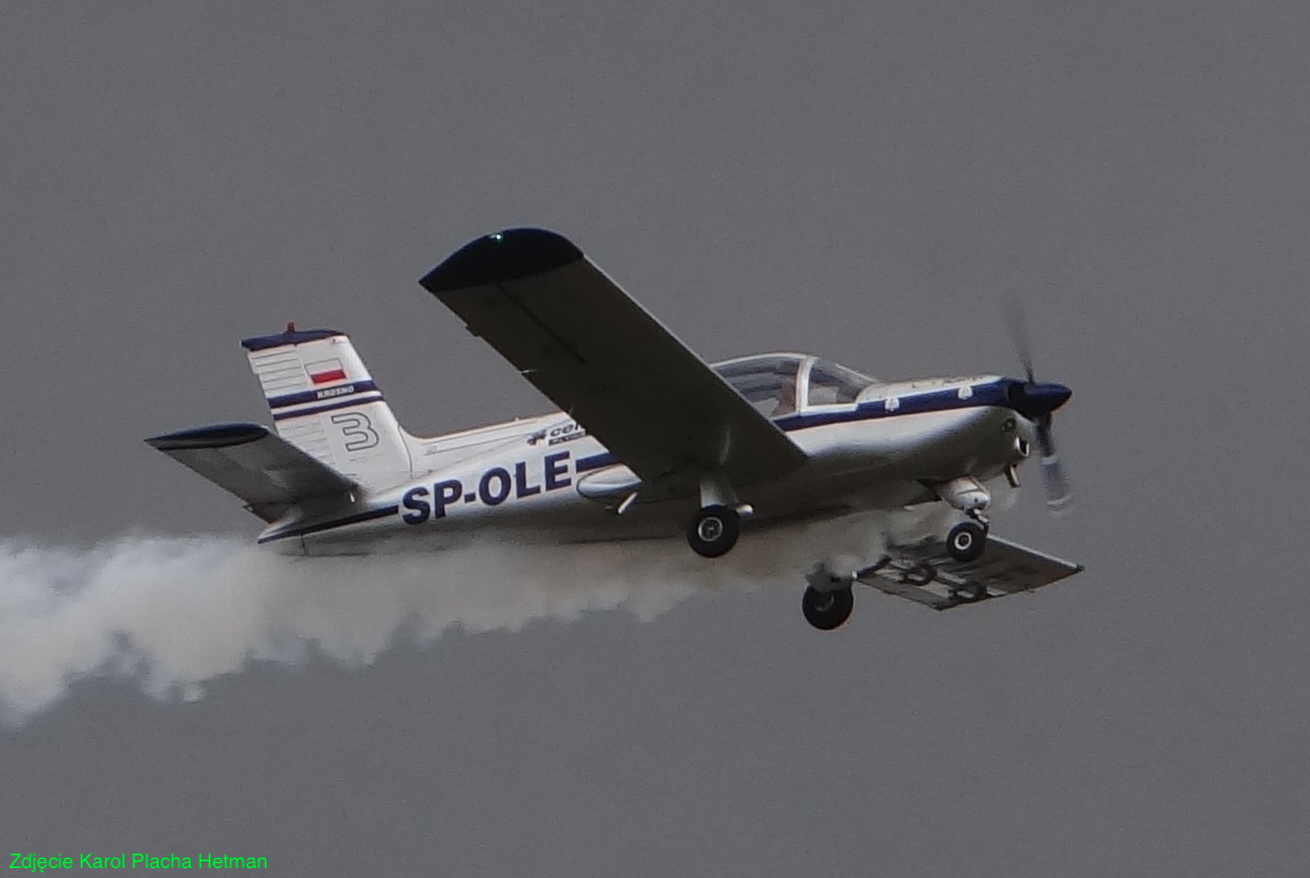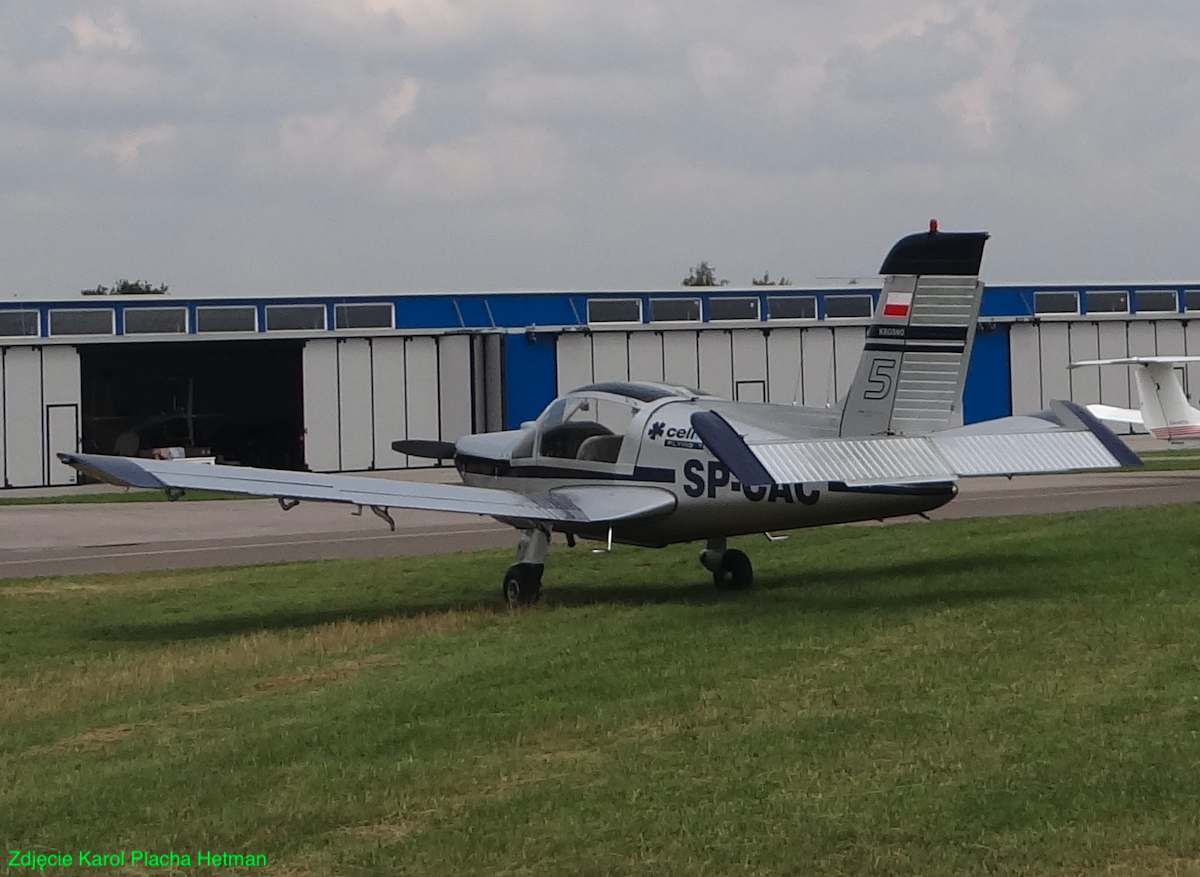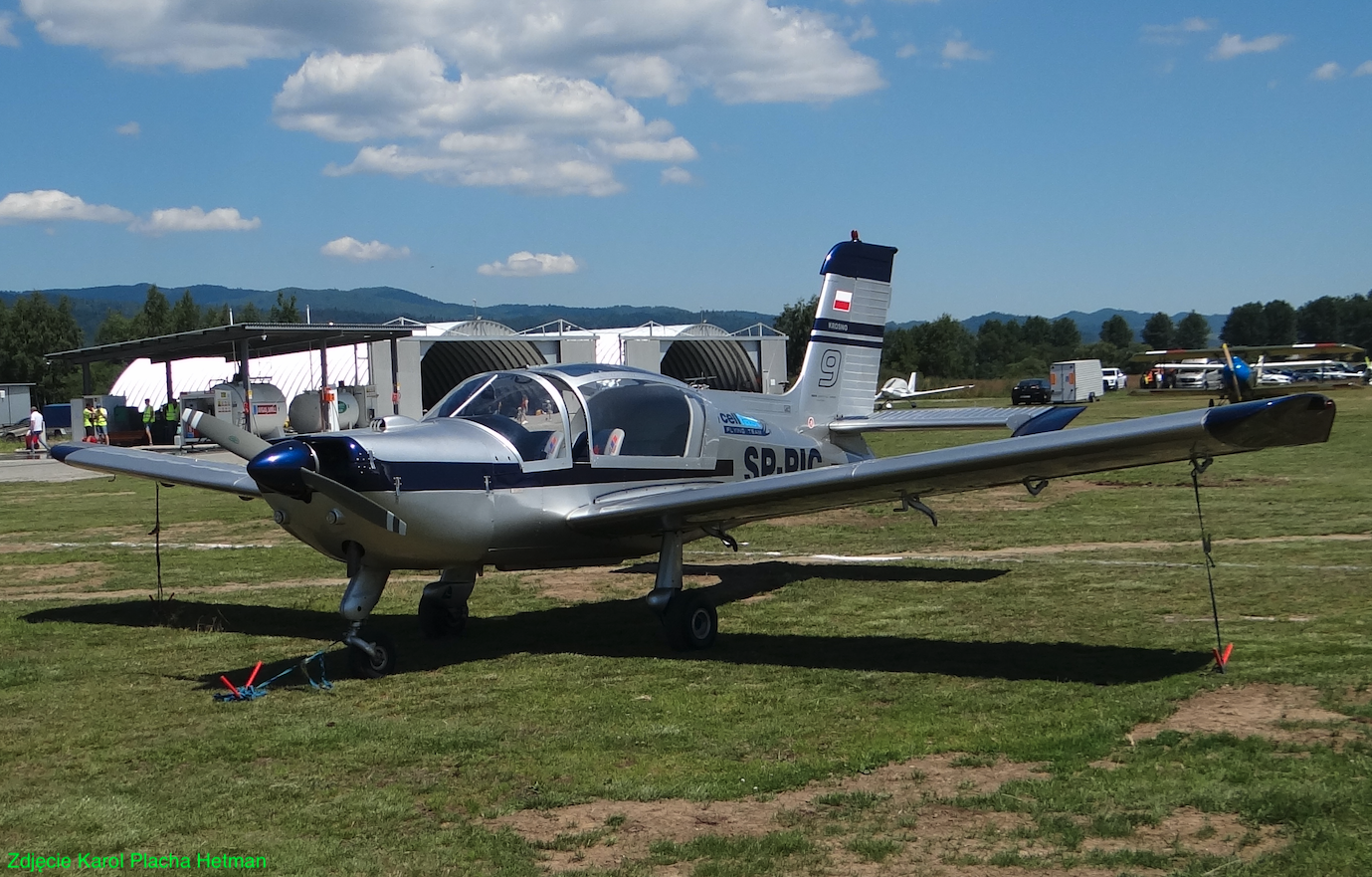Warszawa 2012-04-26
PZL Okęcie PZL-110 Koliber, PZL Koliber 150/150A/160A.
251b Section 18.04.1978 year. Poland. Continuation of the previous chapter.



PZL-110 Koliber 150.
Despite the permanent crisis in the Polish People's Republic, the production of PZL-110 Koliber aircraft went forward. The plane was highly appreciated in Aeroclubs. Also, global trends indicated that the market of small aircraft with small, economical engines would continue to develop. There was also the possibility of exporting aircraft manufactured in Poland to the Western market. Therefore, in 1988, a group of engineers from PZL Warszawa-Okęcie undertook work on modernizing the design of the PZL-110 Koliber aircraft. A thorough analysis gave guidelines for making a number of significant changes. It was decided to replace the existing 85.5 kW PZL-Franklin 4A-235-B31 engine with a stronger, imported and more efficient propeller.
From today's perspective, it looked like this. Officially, there was talk of the need to increase the performance of the PZL-110 Koliber aircraft, because they were a bit low. Implicitly complained about the PZL Franklin 4A-235 engines. It happened that after take-off, the pilot was already looking for an emergency landing site, should the engine start to whim. The facts, however, did not confirm this. The fact, however, was that the plane certified for 4 people had a load capacity of only 110 kg on the back seat, so it was not possible to take 4 adult men on board. This was the main reason for the search for a more powerful powertrain.
Poland managed to obtain a Lycoming O-320 E2A engine with a power of 150 hp. Lycoming O-320 is a popular family of four-cylinder air-cooled aircraft engines. The first variant of this engine was certified by the Federal Aviation Administration in 1952 (No. E-274). The engine powered many well-known school and flying club aircraft. The Lycoming O-320 E2A engine was not produced in Poland.
The prototype marked PZL-110 Koliber 150 registration SP-PHA was flown on September 27, 1988. The pilot was test pilot Maciej Aksler. Tests and flight tests were completed in December 1988. PZL Koliber 150 received a Polish certificate in January 1989, according to French regulations, the same as the PZL-110 Koliber. The aircraft was soon certified in Sweden and Denmark. Both countries were already users of the PZL-110 Koliber version. In March 1990, the aircraft was tested and certified in Great Britain, specifically in the whole of the United Kingdom.
During this time, several lengthy articles appeared in the specialized press in the West. The aircraft received positive reviews. The aircraft is easy to fly, safe, economical and easy to use.
The production of the PZL Koliber 150 aircraft lasted from 1988 to 1990. 25 were built. It should be remembered that the number 110 was no longer used in the construction designation and the new name was PZL Koliber 150.
In 1994, the PZL Koliber 150A variant was created, which was certified according to the American FAR-23 regulations. 19 of these aircraft were built and almost all of them were exported to the USA.
In 1997, a variant of the PZL Koliber 160A was created. The aircraft received a newer version of the Lycoming engine, with a power of 160 hp. The aircraft was certified for a take-off weight of 950 kg, which is 100 kg more than the previous version. At the same time, with such a mass, there were some operational limitations. Among other things, the flaps were not fully retracted, ensuring adequate lift. 12 examples were built. Almost all aircraft were exported to the USA.
Koliber aircraft were sold on the Polish market (38 copies), USA (17 copies), UK (10 copies), Denmark (5 copies), Sweden (5 copies), other countries (14 copies).
PZL-111 Senior.
PZL-111 Senior. Flying clubs expressed their willingness to acquire a Koliber aircraft capable of towing gliders. The program functioned intermittently from 1990 to 1995. The idea was to use a 235 hp Lycoming engine. A prototype was built, flown and all tests were carried out. The production did not take place, because the quiet liquidation of the Polish Aviation Industry was already underway. If there was interest in the plane in the US and a certain batch was ordered, it would be built.
PZL-112 Junior.
The PZL-112 Junior was the last completed variant of the Koliber aircraft. The aircraft did not enter mass production. It had a shortened fuselage and wings. Two-seater cabin. The engine covers were more streamlined.
Cellfast Flying Team.
The Cellfast Flying Team from Krosno has been flying Rallye planes in Poland for several years. The group performs in the country and abroad, giving air shows with three or four aircraft. Airplanes are equipped with a smoke generator.
PZL-110 Koliber design.
The PZL-110 Koliber aircraft is built according to the French AIR-2052A regulations. It is a multi-role, 4-seat, single-engine, all-metal, cantilever, low-wing monoplane with fixed landing gear. Purpose of the aircraft; school and training, sports, available. The plane is simple to use and easy to fly. It is characterized by a short take-off and landing, thanks to the rich mechanization of the wing. It is maneuverable in the air and very maneuverable on the ground, making it easy to maneuver on a small PPS or in a hangar. The structure is designed for overloads of +4.4 / -1.76 g.
The wing of the aircraft is all-metal, cantilever, single-spar, rectangular in outline. A modified NACA 64A416 profile was used. Elevation 7.125 degrees. Wedging angle 4 degrees. Elongation 7.44. The construction is joined by welding and riveting. The wingtips are made of ABS composite. On the leading edge there are two-piece slots, along the entire span. They are tilted automatically. Massively and aerodynamically balanced slotted ailerons. Pusher aileron drive. Tilts 17.5 degrees up and 13.5 degrees down. Aileron area 0.72 m2. Fowler slotted flaps, electrically operated. A landing light was mounted at the end of the left wing. Fuel tanks were installed in the left and right wing caissons.
The fuselage of the aircraft is all-metal, semi-monocoque, oval-rectangular in cross-section. Frame structure and stringers. The cover is joined by welding and riveting. In the front part, the power unit is placed, consisting of a 4-cylinder boxer engine, air-cooled and a two-blade propeller. Motor housing made of composites in the form of two elements. The shields were built by PZL Bielsko. Behind the engine is a covered passenger compartment with four or three seats. The cabin is air-conditioned, heated and ventilated. The cabin is richly glazed with large windows. It consists of a fixed windshield and a rear-moving fairing. The fairing is equipped with a protection system against accidental opening during flight. In the cabin, various covers and the dashboard panel are made of ABS-marked plastic, previously unknown in Poland. Double tillers (double rudders); classic stick and pedals. Pusher aileron drive. rudder drive; pushers and tie rods. Electric wing flaps. Side-by-side adjustable front seats with fixed or inertial seat belts.
The construction technology of the Rallye airframe in the 1970s was different from that used in Poland at that time. We used clad sheets, i.e. covered with a layer of oxides, to build airplanes. In France it was different. The basic elements of the airframe were made of unclad sheets. The main method was spot welding. Immediately after welding, the welds were inspected. If any weld did not hold, it had to be corrected. Then, the entire element was put into a bathtub to be chemically or electro-chemically coated. In Poland, a problem arose that clad sheets could not be welded. (The coating has a higher melting point. Therefore, a hole is easily burned during welding.). The plated coating had to be removed first. The welding technology in Poland was then used in PZL-106 B Kruk (wing elements) and PZL-130 Orlik (hull sides and other small elements). In addition to welding, several types of rivets were used; double crimped rivets, core flattened rivets, blind rivets.
Classic tail with division into rudders and fins. Undivided horizontal tail. Single-girder, semi-shell construction. The rudders are massively and aerodynamically balanced. There is a balancing tab on the elevator and corner compensators on the ends. The hull-tail transition is equipped with a profiled inlet. Elevator tilted; 30 degrees up and 25 degrees down. Rudder tilted 30 degrees. rudder drive; pushers and tie rods. The horizontal tail area is 3.48 m2. Vertical tail area 1.74 m2.
The aircraft landing gear is fixed, three-support, with a nose wheel. Undercarriage base 1.71 m, main landing gear spacing 2.01 m. Semi-cantilever construction. Front chassis equipped with one wheel on a semi-fork, with a stabilizing mechanism, steered. Front wheel with pneumatic dimensions 330x130 mm, with a pressure of 0.14 MPA (1.4 kg/cm2). Main landing gear with single wheels attached to wishbones with shock absorbers. Two-stage oil-gas shock absorbers. The wheels of the main landing gear with pneumatics, dimensions 380x150 mm, with a pressure of 0.18 MPa (1.8 kg/cm2). Legs made of steel pipes and steel elements, welded. Legs of earlier aircraft made of reinforced duralumin. Shins profiled with composite fairings. Disc brakes, hydraulic. Hydraulic installation of the PZL system. Standard parking brake.
Engines.
The drive unit consists of one four-cylinder air-cooled engine. The engine is defined as flat, with two cylinders on each side. The difference between a flat engine and a boxer engine is as follows: Externally they look the same. The difference is in the crankshaft. In a V-engine, the connecting rods of the opposing cylinders are on a common pin and the pistons move in the same direction, rather than opposite, as in a boxer engine where the connecting rods have separate pins. PZL Franklin engines or Lycoming O-320 engines were installed.
PZL Franklin engine. 4-cylinder and 6-cylinder engines were produced (mounted in PZL M-20 Mewa. These engines produced in Poland were naturally aspirated, but they can be turbo-charged. The construction of the engine is very compact. The front surface of the engine is small, which reduces aerodynamic drag The engine is air-cooled The main body of the engine is made of cast iron alloys The valves are equipped with a hydraulic self-adhesive device No need to set the valve clearances PZL-Franklin 4A-235B3, 93 kW (125 hp).
Lycoming O-320 E2A engine, 150 hp. 4-cylinder design, flat.
The oil system has an oil tank that is an integral part of the engine crankcase. Oil pump mounted in the tank. The oil system also includes an oil cooler and a thermostatic valve, short and long circuit. The capacity of the oil system is 8 liters. Oil used in the 70s, Aero-Shell SAE 20-50.
The fuel system consists of two welded light alloy tanks placed in the wings. Capacity 105 liters. Conduits made of tubing, and flexible conduits in the engine area. The fuel pump is located next to the engine. The installation has a fuel meter and a shut-off valve. The fuel is aviation gasoline with a minimum of 80/87 octane.
12 V electrical system. 12 V 18 Ah battery, alternator, starter motor, flap drive actuator, power supply for on-board instruments, position lights, collision lamps, landing spotlight, radio power supply, airport power socket.
Installation of pressure transmitters (pitot tube) of on-board instruments, with drainage system.
The aircraft cabin equipment includes a set of instruments depending on the customer's wishes. There are also different manufacturers of these components to choose from. Typically, aircraft were ordered with a basic set of instruments, and it was retrofitted in the user's country. There are basic and special instruments. Could be ADF, VOR. Narco Mk.12D or Bendix/King KX-155/165 VHF radio. In 2012, the price of such a communication radio was $4,500.
PZL-110 Koliber T-T data:
Span 9.70 m. Length 7.20 m. Height 2.80 m. Bearing area 12.70 m2. Curb weight 510 kg. Total weight 850 kg. Payload 350 kg. Top speed 195 km/h. Cruising speed 170 km/h. Climb speed 2.5 m/s. Maximum range 730 km. Ceiling 3,350 m. Take-off run 155 m. Landing run 150 m. The plane practically takes 3 people on board.
PZL Koliber 150 T-T data:
Span 9.74 m. Length 7.30 m. Height 2.80 m. Bearing area 12.88 m2. Curb weight 548 kg. Total weight 770-850 kg. Payload 350 kg. Top speed 200 km/h. Cruising speed 140 km/h. Climb speed 4.4 m/s. Maximum range 590 km. Ceiling 3,700 m. Take-off run 140-167 m. Landing run 125-138 m. The plane practically takes 4 people on board. A total of 90 were produced.
Tally.
Rallye 100 registration F-BXMZ, March 1976. The first Rallye aircraft made available for comparative tests at Okęcie Airport. R-R Continental O-200A engine.
Rallye 100 ST registration SP-WGA / F-ODDF No. 2743, June 1976. Airplane brought to Poland by air by a Polish pilot. During this flight, a dangerous situation occurred in Czechoslovakia. The aircraft was the first benchmark aircraft. R-R Continental O-200A engine.
Rallye 100 ST registration F-ODER / No. 2845, February 1977. The second model aircraft. R-R Continental O-200A engine.
Rallye 100 ST registration F-ODES / SP-WGC / No. 2855, February 1977. Third reference aircraft. R-R Continental O-200A engine. Assembled in Poland and flown on April 18, 1978, with PZL Franklin engine. It was shown at the Farnborough Salon (September 4-7, 1978).
Rallye 100 ST registration F-ODEQ / 2856, February 1977. The fourth reference aircraft. R-R Continental O-200A engine.
The first production series consisted of 36 copies. Among them were SP-TKA, SP-TKC, SP-TKD aircraft, which were used at the Aviation Personnel Training Center in Rzeszów.
PZL-150 registration 19005 / SP-ZKC / SP-PHA, September 28, 1988. PZL-150 prototype, registration SP-PHA, rebuilt from PZL-110 SP-ZKC. Lycoming O-320 engine.
PZL-150. The first production series consisted of 22 copies, production period 1993-1995.
PZL-150 A prototype, registration SP-WHB / 3930058, June 5, 1993.
PZL-150 A. The first production series consisted of 16 copies, production period 1993-1995.
PZL-111 prototype, 950001 / SP-PHI, September 13, 1995. Lycoming O-540 engine.
PZL-160 A prototype 4980078 / SP-PEB, March 23, 1998. Lycoming O-320 D2A engine.
PZL-160 A. First production series. Eleven examples were built between 1997 and 2004.
PZL-112 prototype, registration 0001 / SP-PRG, June 10, 2000. Lycoming O-325 L2C engine.
The last built serial Koliber PZL-160 A No. 4020089, May 4, 2004. According to the factory numbering, 89 PZL Koliber aircraft were built. Nos. 90 and 91 were unfinished. In 2004, Freemasonry sold the PZL Okęcie plant. The plant began operating as a manufacturer of spare parts for the Airbus concern and maintenance of CASA C-295 transport aircraft. The production lines of the PZL-110 Koliber and PZL-106 Kruk (agricultural aircraft) were liquidated, the templates destroyed, the documentation burned.
Written by Karol Placha Hetman
